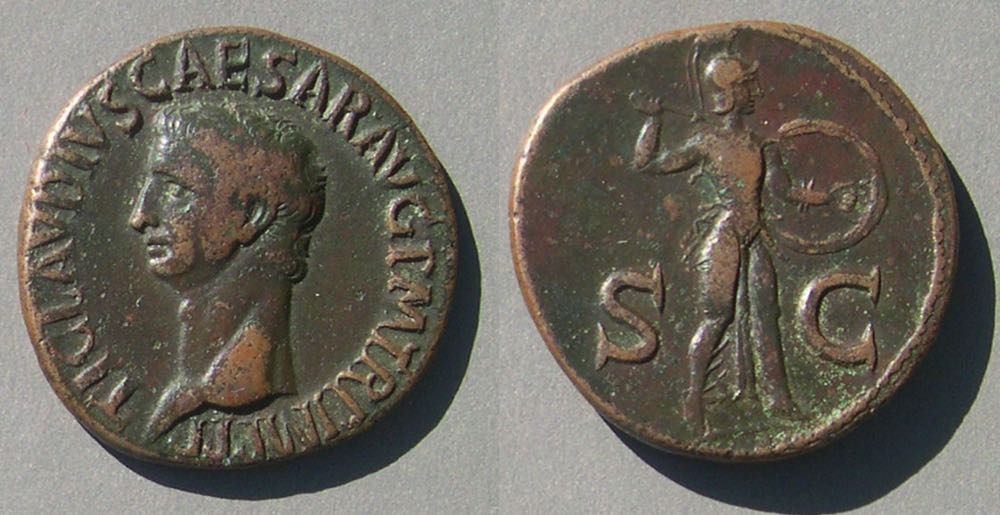 Claudius (AD 41-54) and related ancient imitation coins
Claudius (AD 41-54) and related ancient imitation coinsincluding Augustus, Agrippa,and Tiberius/Claudius (Claudius first, then the earlier types.)
 Claudius (AD 41-54) and related ancient imitation coins
Claudius (AD 41-54) and related ancient imitation coins
including Augustus, Agrippa,and Tiberius/Claudius (Claudius first, then the earlier types.)
In AD 43 Britain was invaded and conquered under Claudius. Apparently, thereafter the demand for coins far exceeded the official supply and locals began minting imitations of AE prototypes of Claudius. The most commonly imitated prototype is the copper as with Minerva right brandishing spear and shield reverse seen to the right.
Prototype: An official genuine coin of Claudius with his bare head left
TI CLAVDIVS CAESAR AVG PR TRP IMP PP
/S C on either side of Minerva brandishing spear in right, holding shield in left
28 mm. 11.12 grams. Die axis: 6:30.
RIC 116. BMC 207. Struck c. 50-54.
RIC I, 100, plate 16 says "weight peak c. 11.25 - 9.50 grams." Most of the imitations weigh distinctly less.
Sutherland, Imitations, NNM 65 classifies imitations by fidelity to this original. Banti &Simonetti XV, pages 70-136 has many imitations illustrated.
A second imitated type, the SPES AVGVSTA sestertius, in discussed below. Most British imitations of AE must be regarded as "money of necessity" rather than imitations for profit. Only a small fraction could be deceptive; many are obviously much smaller, lighter, and cruder than the official coins. But they seem to have been commonly used and some were even validated by countermarks.
The imitations here are of varying degrees of resemblance to the prototype.
1) Minerva reverse, full-size and nearly official style, followed by cruder and smaller examplesen Esty (c) Copyright
2) hybrid with obverse of Tiberius
3) Balkan SPES sestertius imitations, countermarked for validation as acceptable
4) CERES, very close to official style
5) ROM ET AVG imitation of Augustus
6) Agrippa
Imitations of Claudius with Minerva reverse:
 28 mm. 6:30. 12.63 grams
28 mm. 6:30. 12.63 grams
Could this be official? It is full size and full weight, but the heavy brow of the portrait makes it a close call.
 26 mm. 5:00. 7.86 grams.
26 mm. 5:00. 7.86 grams.
Good style. Excellent lettering. Could almost be official and poorly struck, but for the light weight.
...CAESAR AVG PM TRP
/Usual reverse, "S" flat struck.
Reference: B&S XV, 569/1.
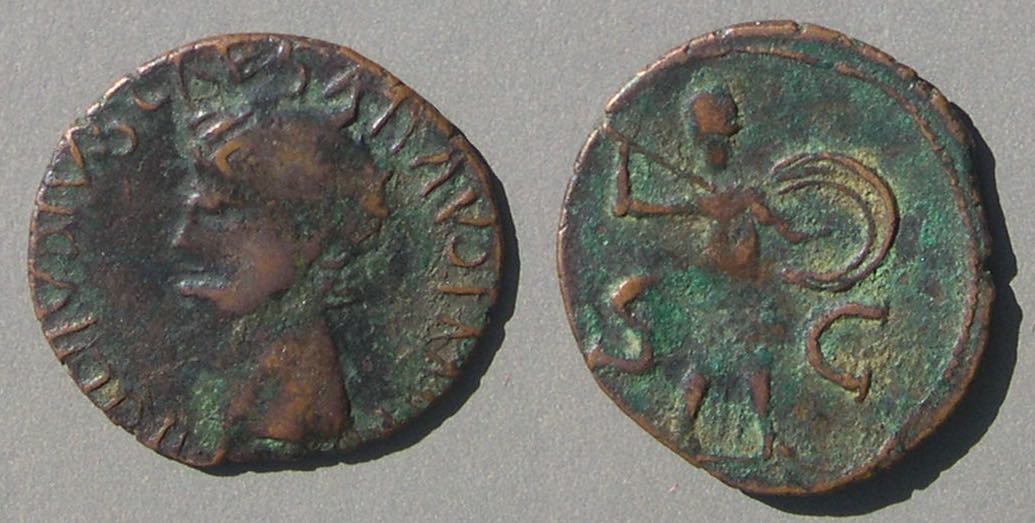 27 mm. 3:00. 5.04 grams
27 mm. 3:00. 5.04 grams
This crude imitation on a thin flan has almost full lettering which is not far from the letter-forms of the prototype. One can almost make out:
TI CLAVDIVS CAESAR AV[G] I... in irregular letters.
The reverse is not far from the official style.
 25-22 mm. 6:00. 5.48 grams
25-22 mm. 6:00. 5.48 grams
Crude style. Only a hint of lettering.
/"Minerva" seems to be rendered as a male.
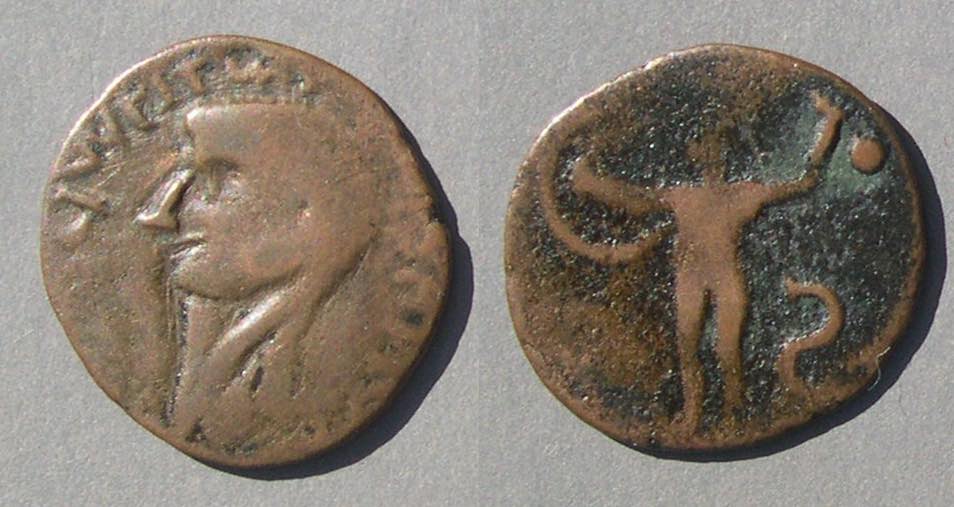
24 mm. 11:00. 4.81 grams
Retrograde reverse.
Obverse legend very crude with letter-like forms, but not real letters.
 24 mm. 6:00. 3.93 grams. Thin flan.
24 mm. 6:00. 3.93 grams. Thin flan.
No legible letters, nose weak.
/Clear Minerva, bold S C.
 26 mm. 6:00. 5.64 grams.
26 mm. 6:00. 5.64 grams.
Small bust. Weakly struck. Well-formed letters. Good style. Edge shows no signs of casting.
... SAR AVG PM TR...
Close to offical style, but light weight.

26-22 mm. 9:00. 6.83 grams.
Irregular style. Some legible letters. Much flat striking.
... VDIVS C... M...
/shield and "S" flat on reverse.
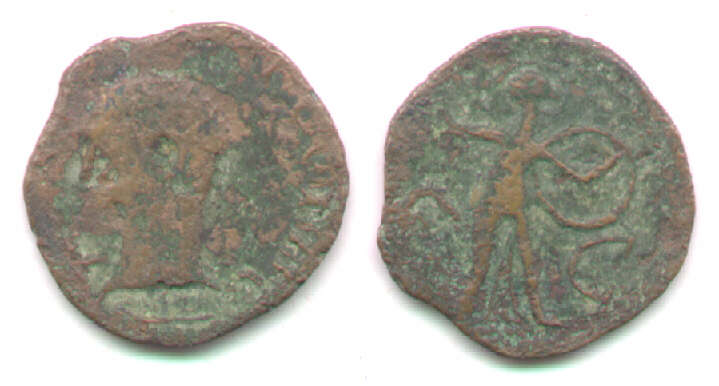 26 mm. 5:30. 5.62 grams.
26 mm. 5:30. 5.62 grams.
Head very crude, with a very weak face. (Lots of corrosion.) Traces of letters 1:00-5:00.
Crudely sketched Minerva, with crude S C.
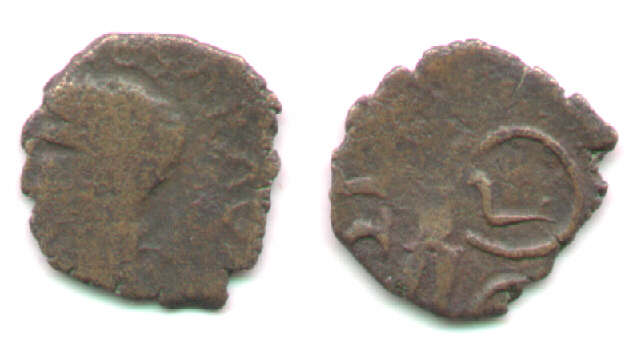 23 mm. 4:30. 3.93 grams.
23 mm. 4:30. 3.93 grams.
Very much off center to 9:00. Weak letters, perhaps ...SARAV...
/Minerva's body flat struck, but shield bold. S C 2/3 clipped.
Reference: This piece is the plate coin in P. J. Casey Roman Coinage in Britain, plate 8.5.
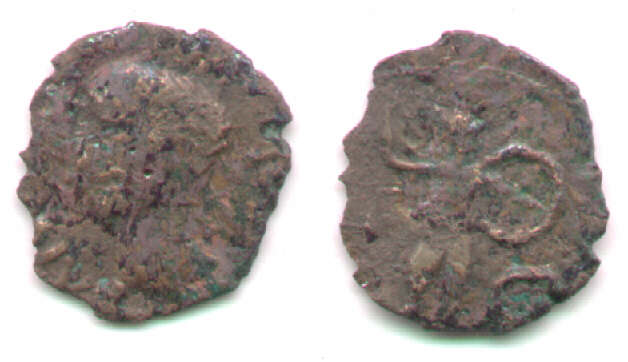 24-21 mm. 6:00. 3.95 grams.
24-21 mm. 6:00. 3.95 grams.
Crude, thin sharp edges, porous, very corroded.
Some traces of letters.
/S C both clipped by edge of flan.
The weight is much less than the 10-11 gram prototypes.
Tiberius obverse with Claudius reverse
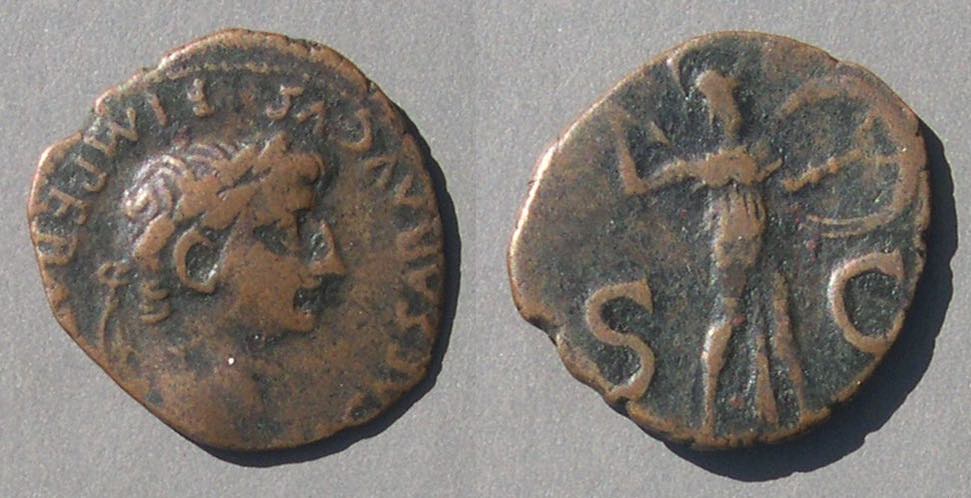 24-22 mm. 6:00. 4.62 grams
24-22 mm. 6:00. 4.62 grams
Good style Tiberius obverse. British find.
[TI] CAESAR AVGVS F IMPERA...
Laureate head of Tiberius right
/Minerva
Prototype: Obverse of "ROM ET AVG" dupondius, BMC 575, see plate 21.4-5 "AD 9-11"
Imitation, reference: B&S IX p. 206 ff, #36 obverse; 371 is this type hybrid with different dies, p. 222.
Claudius with LIBERTAS AVGVSTA reverse
 An as. 30 mm. 12:00. 10.41 grams.
An as. 30 mm. 12:00. 10.41 grams.
Prototype LIBERTAS AVGVSTA
Liberty standing right, holds cap behind in right hand
TI CLAVDIVS CAESAR AVG PM TRP IMP PP
Protoype: RIC 97. BMC 145. Struck AD 41-45 or 41-50.

imitation: 27-25 mm. 6:00. 10.28 grams.
Very low relief. Full weight, but smaller in diameter.
Three countermarked imitations, possibly from the Balkans.
The countermarks serve to make unofficial coins officially acceptable, sometimes at a reduced value, as with the sestertii below which are marked "DV" to indicate the value of a dupondius.
These are not British.
 27 mm. 6:30. 7.05 grams
27 mm. 6:30. 7.05 grams
BON countermark. This coin may be from the Balkans, not Britain.
Kraay, in Essays Mattingly, suggests the BON countermark may have been applied under Nerva or Trajan. This coin is very worn, compatible with having circulated a long time.
BMC 164, a sestertius, and 184, a sestertius, both imitations, have this BON countermark, but there are no photos.
B&S 61/9 has BON countermark = Hunter I, 17.67 (7.87 g) with different countermark die.
Weakly struck imitation of the SPES AVGVSTA type sestertius. (Prototype second-next below.)
Countermarked "DV" which is not listed in BMC I and therefore probably not a western countermark, supporting the dealer's attribution "from the Balkans".
Obverse legend almost all gone (or never there) but faint traces of "...R AVG PM .."
Reverse legend, if any originally, flat.
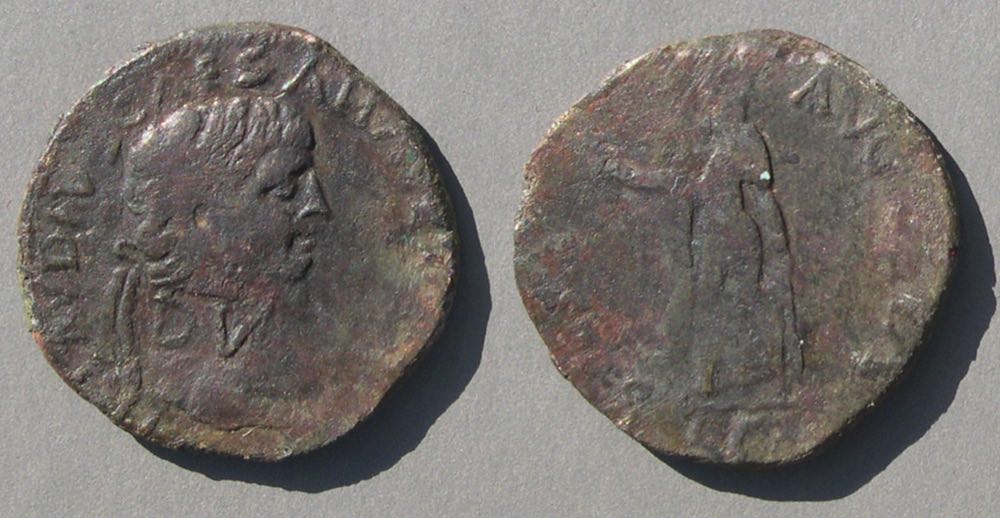 32 mm. 6:00. 13.47 grams
32 mm. 6:00. 13.47 grams
Better struck imitation of the SPES AVGVSTA type sestertius. (Prototype next below.)
Countermarked "DV" which is not listed in BMC I and which is coming to be recognized as from the Balkans.
Obverse legend: ...CLAVDIVS CAESAR AVG ..."
Reverse legend weak, but visible: SPES AVGVSTA .
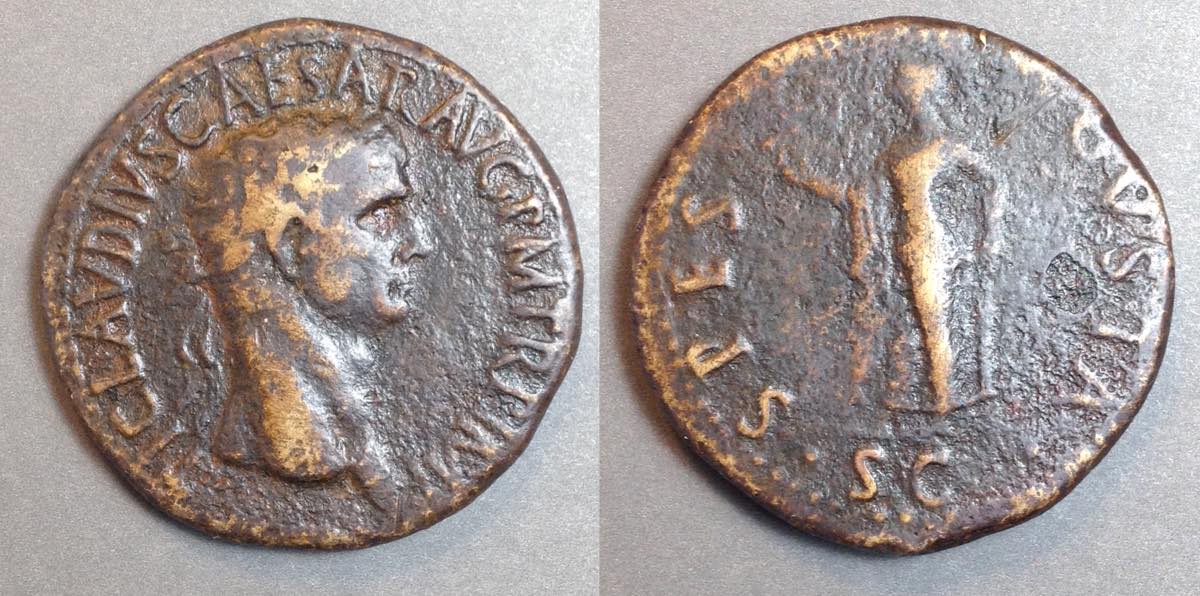 AE35.
AE35.
Official prototype: Sestertius of Claudius. SPES AVGVSTA, Spes standing left, holding flower. Warren Esty (c) Copyright
This type was copied in Britain, but not as commonly as the Minerva as.
This site has no illustrations of British imitations of this type--which I think are quite rare. The previous sestertius imitations are from the Balkans, not Britain.
Claudius, CERES AVGVSTA
 AE27, 5:00.
AE27, 5:00.
Claudius imitation in excellent style. It is difficult to decide if this might be official. Official examples seem to have (weakly) barred A's. If this is truly an unofficial imitation, it is a remarkable one.
TI CLAVDIVS CAESAR AVG PM TRP IMP
/CERES AVGVSTA, Ceres seated left, veiled and draped, on ornamental throne, holding 2 grain ears and nearly-horizontal long torch.
Prototype: RIC 94. See also RIC 110 of "c.50-54". B&S XIV pages 217-233. See 372 a "provincial imitation." See 361/1 for dotted throne parts.
Obtained in Britain with a ticket calling it a "Romano-British imitation."
Claudius as, possibly official, but a close call.
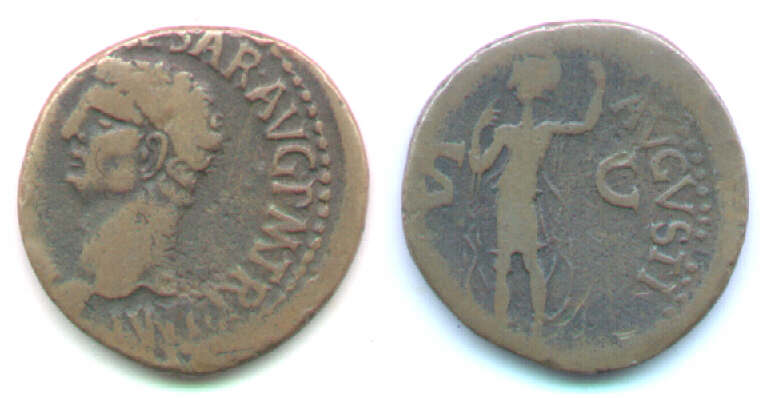 AE28-27, as, 6:00, 10.57 grams.
AE28-27, as, 6:00, 10.57 grams.
This piece is badly off-center, the portrait is of slightly "heavy" style, and the reverse figure looks primitive. But, the weight is right and the die-axis is right and the lettering is good. The diaphonous dress on Constantia is well done. All in all, I'll guess this one is official.
/[.....]ESAR AVG PM TRP IMP, laureate head left
/[CONSTANTIAE] AVGVSTI, Constantia standing left, hand raised to mouth.
Reference: RIC 95, plate 16, page 127, of "AD 41 - 50(?+)".
I have included this coin in order to recommend Banti and Simonetti's volumes called "Corpus Numorum Romanorum" which have pages and pages on every type of Claudius, including 27 pages on this type (in volume XV), with numerous imitations illustrated in addition to the numerous official examples. The line between "official" and "imitation" can be fine. Many British types are too crude to mistake for official coins, but some pieces (like this one) are cruder than the best official examples but not so crude as to make it easy to decide. I would not be surprised if some other experts pronounced this one an imitation.
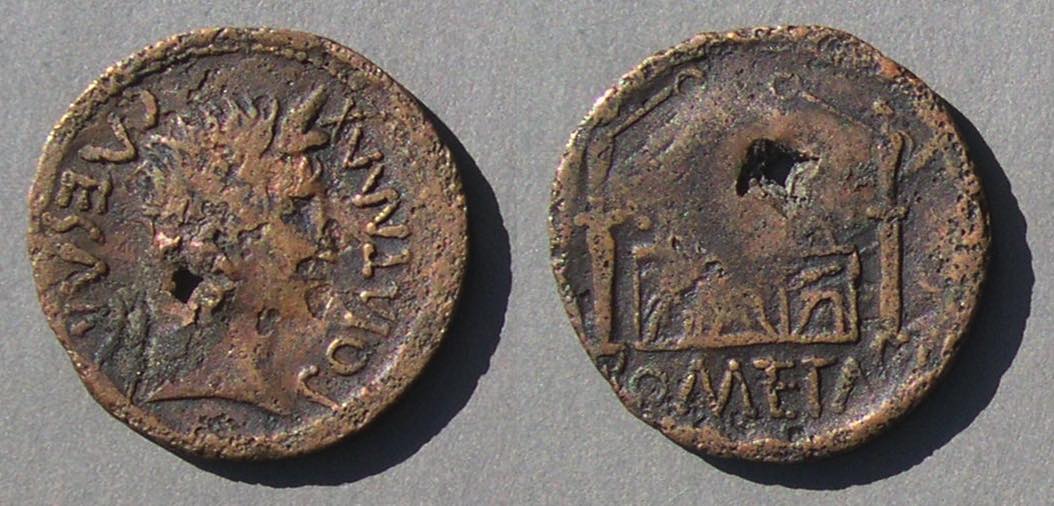 Leaded AE26, as, 4:00, 6.54 grams.
Leaded AE26, as, 4:00, 6.54 grams.
Imitation. A British find.
Flat strike further defaced by a square piercing from the reverse side, perhaps by a nail.
CAESAR PONT MAX/bare head of Augustus right
/ROM ET AV [sic] (It should finish AVG) beneath altar of Lugdunum dedicated to Rome and Augustus.
columns on either side topped with Victories holding wreaths in outstretched (very long) arms
Ref: (old) Sear 510. Sear 1690. RIC 230 "c. 15 BC - after 10 BC." BMC 550, "10 - 6 BC(?)".
Banti & Simonetti, volume VI, pages 103-116. "11 BC - 8 BC at Lugdunum." Most examples are c. 11.5-9.0 grams.
The lead component can been seen in the piercing (looking at the coin itself, if not the scan). The coin is somewhat smaller in diameter than its prototype and a bit too thin, which explains why it is so underweight for the type. This alone condemns it as false. In addition, the reverse style is a bit off and the exergual legend is incomplete. Perhaps the piercing was to deface the coin when it was detected as false.
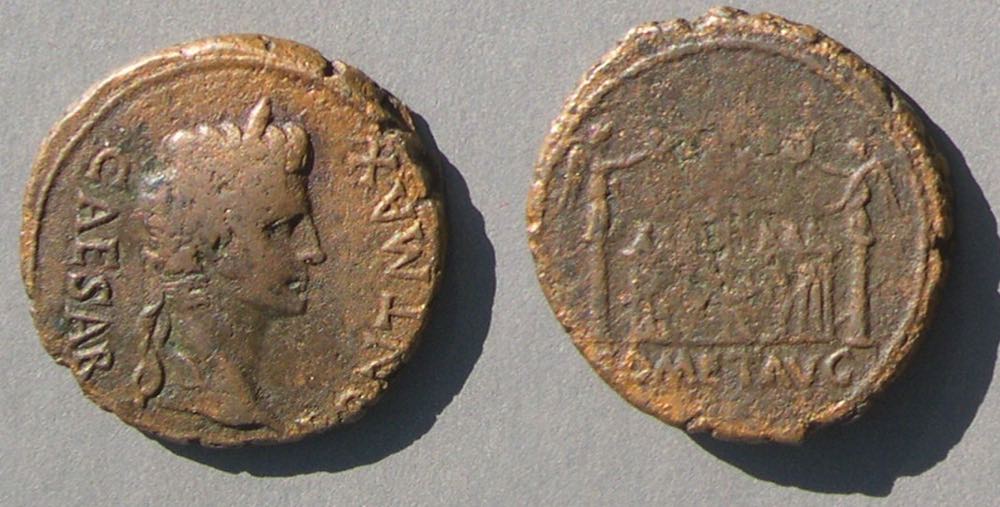 Prototype of the above imitation.
Prototype of the above imitation.
26-25 mm. 11.02 grams.
ROM ET AVG below altar of Lyons, flanked by Victories on columns.
RIC 230.
Agrippa (prototypes struck by Caligula, AD 37-41)
 27-26 mm.
27-26 mm.
Crude obverse legend -- better reverse legend.
head of Agrippa left, letter forms suggesting ... AVGVSTVS ... around
/reverse of Divus Augustus type (see previous coin)
/PROVIDENT below altar, S C on either side
Reverse prototype RIC 80, page 99, with portrait of Agrippa from Gaius (Caligula) 58.
Reverse prototype B&S VI page 88f, barbaric pieces not like this, p.98-101.
Obverse B&S VIII pp.90-99, with imitations p. 100-102-104, but not this reverse.
The next coin is obverse die-identical, which is very unusual.
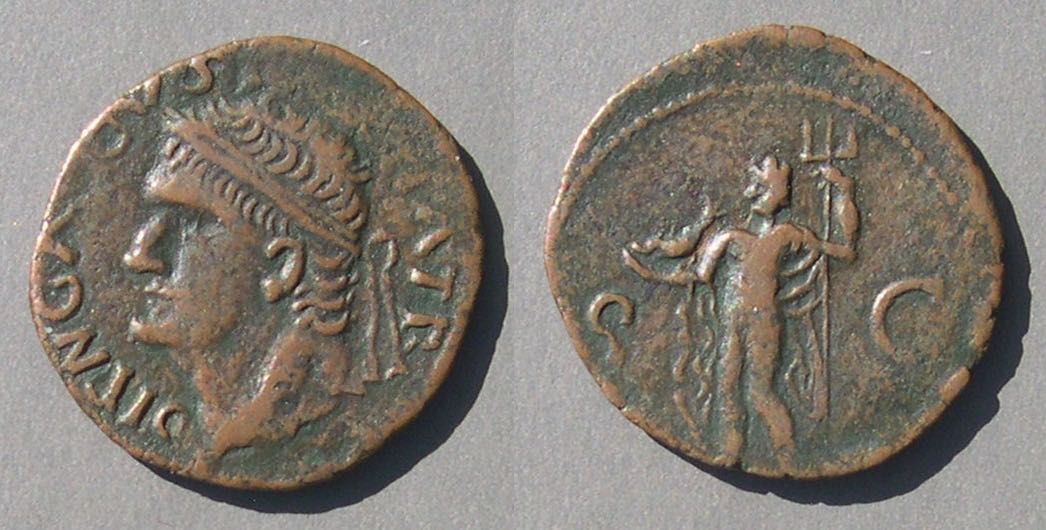 Imitation. 26 mm, and its prototype below.
Imitation. 26 mm, and its prototype below.
Obverse die-identical to the previous coin. However, this one has the usual Agrippa reverse.
/Neptune standing left, holding dolphin and trident
RIC 58, page 112 comments in note 58, "many hybrids and imitations exist, in both cases extending over a considerable period of time."
B&S VIII prototype p. 83-99, with imitations p.100-1, 14 pieces but none very similar.
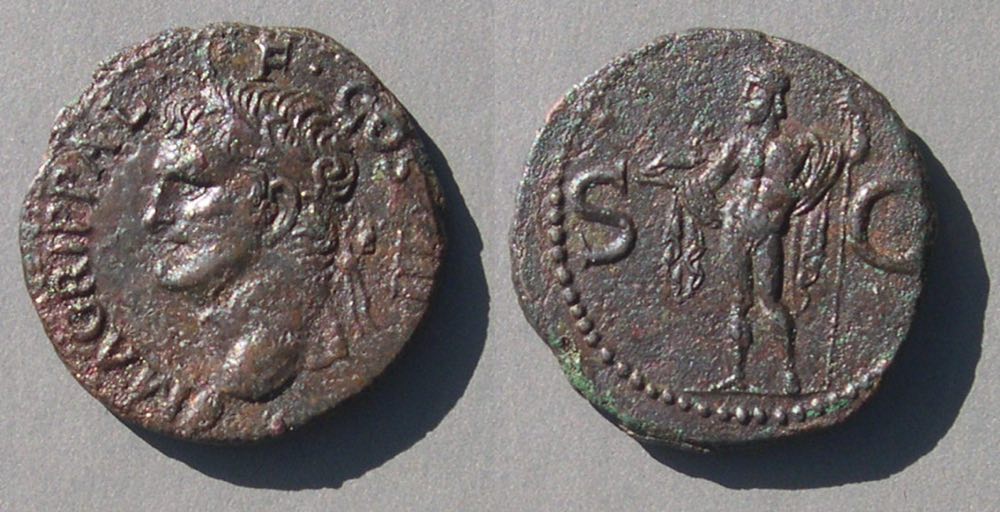 Prototype here: 27 mm. 10.32 grams. 6:00
Prototype here: 27 mm. 10.32 grams. 6:00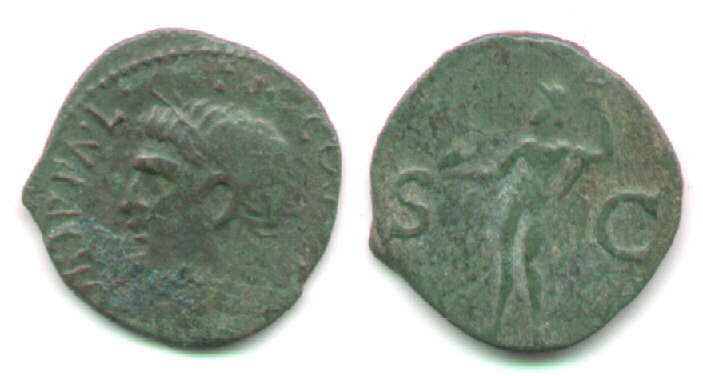 25 mm. 7:00. 5.57 grams
25 mm. 7:00. 5.57 grams
Light weight imitation of good style. Official pieces are 9-13 grams. (See prototype above)
[M A]GRIPPA L F COS [III]
/Neptune standing left, holding dolphin and trident
B&S VIII p. 83-99 for the prototype, p. 100-1 for imitations.
Boon C&A plate III.36 (3.96 grams)
Continue with other 1st and 2nd century AE imitations.